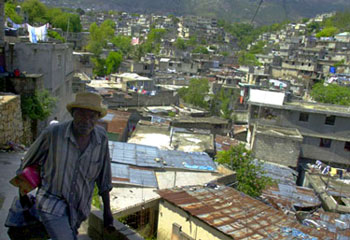By George Curry
-Guest Columnist-

MILOT, Haiti – When Ron Daniels invited me to join his recent Haiti Support Project’s pilgrimage to the cities of Milot, Cap-Haitien and Port-au-Prince, I had mixed feelings. I have traveled around the world, but my trips to the Pyramids in Egypt and the Door of No Return on Goree Island in Senegal were the most memorable–and emotional. I had no doubt that a trip to Haiti would also strike a special chord.
Since childhood, my stepfather had told me how Toussaint L’Ouverture led a successful slave uprising against the French, paving the way in 1804 for Haiti to become the first independent Black nation in the Western hemisphere. The invitation to visit an island where Africans were dropped off before slave ships continued the journey north was irresistible. We are all Africans, whether living in Haiti or the U.S.
But that’s not how we’re labeled. Usually, when public officials or leaders mention Haiti, they invariably describe it as “the poorest nation in the Western hemisphere.” With most Haitians earning only $2 a day, I didn’t know how I would react to seeing such massive poverty.
After a four-hour flight from New York’s John F. Kennedy Airport aboard American Airlines Flight 837 to Toussaint L’Ouverture International Airport in Port-au-Prince, we transferred to a small puddle-jumper for the 30-minute trip north to Cap-Haitien. We attended a reception that night hosted by Minister of Tourism Patrick Delatour, a graduate of Howard University. The next morning, we were bussed 30 miles to Milot (pronounced Mi-lo) and that’s when we really got a look at abject poverty.
Although the poverty may be more concentrated in Haiti, it is not noticeably different from the poverty I had observed in Senegal, Nigeria, Egypt or the backroads of Cuba. But seeing so many people–children in particular–so poor prompted two immediate actions. First, I realized that poor people back home, even those living in the South Bronx and the Mississippi Delta, the two poorest regions in the United States, seem wealthy when measured against the typical Haitian. Second, as I looked into the innocent eyes of children, I couldn’t help but think: Suppose I had been born here? What could I realistically expect from life? After reflecting, you thank God for your blessings.
In general, children are the same regardless of where they live. Here, they are curious, they wave eagerly at the sight of tourists and, more than in the U.S., they run around in their bare birthday suits.
Also surprising was the age at which some children are expected to carry out chores. I saw several girls who appeared to be no older than five years old, carrying buckets of water. I saw some, appearing to be 7 or 8, balancing large items from the market on their head.
Much has been written about the dire poverty in Haiti, but rarely are articles written about the creativity or ingenuity of the people. There are talented artists living in every region of the country and they are eager to negotiate an acceptable price for their works. The arts and crafts are impressive. And if I were to count people in Haiti who tried to sell me something rather than seek a handout, the entrepreneurs would lead at least by a 4-to-1 margin. Carvings. Fruits. Paintings. Beads. Jewelry boxes. Knives. Canes. You name it, they had it.
Ron Daniels, Black America’s unofficial at-large ambassador to Haiti, had a two-fold goal for this mission: one, to take 50 people with him to see for themselves what Haiti is like in hopes of making them ambassadors and, two, announce a “model city” program in which the Haiti Support Project would adopt Milot and actively aid in its economic and educational development.
Because of the consistent work of the Haiti Support Project, led by Ron Daniels and his wife Mary, the touring African-American guests were given access to the highest levels of government. Legislative leaders and cabinet ministers attended receptions in the group’s honor; Janet Sanderson, U.S. ambassador to Haiti, hosted a reception at her residence and President Rene Preval gave a farewell reception recently in the group’s honor at the Presidential Palace. But neither of those was the highlight of the trip.
That honor came when Ron Daniels unveiled the architectural plan for an empowerment and visitors center in Milot. Hundreds of children had gathered for the presentation and when the drawing was unveiled, they cheered loudly, excited that descendants of Africans in America had not forgotten about the descendants of Africa in Haiti.
(George Curry is editor-in-chief of the NNPA News Service and BlackPressUSA.com. Visit his website at www.georgecurry.com.)












